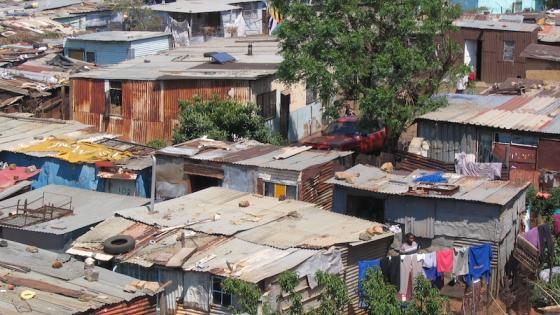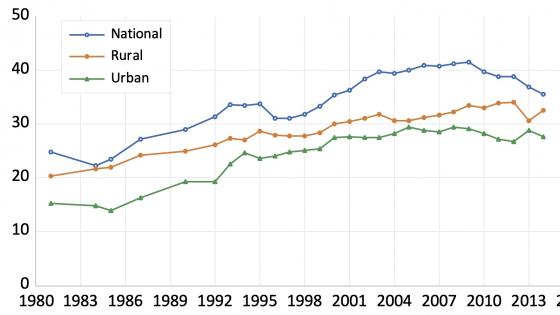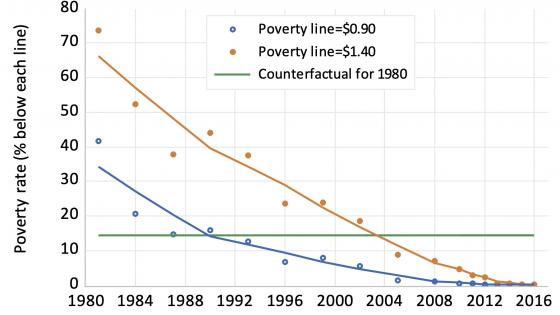There is much talk these days about the idea of a basic income. This is an untargeted transfer, set at the same level for all recipients within a domain. It is variously called ‘citizenship income’, ‘universal basic income’ or (my favourite) ‘basic income guarantee’ (BIG). The debate for and against the BIG idea spans the globe. A BIG is often contrasted with a set of targeted transfers that would fill all the poverty gaps.
Both sides of this debate have set up straw men.
Straw man 1: A BIG is too expensive
Critics of the BIG idea argue that it costs far too much to be considered seriously. Some BIG proposals have had scary price tags, but that misses the point. Most countries (including many poor countries) already spend public money on poverty reduction. If the same resources would be better spent fighting poverty using a BIG, then that’s what should be done. We can ask this question for any given level of the basic income.
India, for example, has subsidies that benefit the non-poor more than the poor. Cutting these and replacing them with some form of BIG would almost certainly have greater impact on poverty. More remarkably, a BIG might well be more cost-effective against poverty than India’s main programs targeted to the poor, namely the Public Distribution System (for subsidised food) and the National Rural Employment Guarantee Act (NREGA), a workfare programme that aims to be self-targeted to poor people. In research with colleagues we have found that a small basic income in Bihar, one of India’s poorest states, would have more impact on local poverty than the labour earnings from NREGA (Murgai et al. 2016).
A key element of the case for a BIG is how it would be financed. Progressive income taxes are an option in rich countries, and then the BIG is formally equivalent to Friedman’s (1962) negative income tax. When financed by reduced expenditures on other public programmes, the benefits and costs of those programmes should be considered. That could make a BIG proposal look worse if it was introduced at the expense of (say) better quality schooling, or healthcare for poor people. Fine, let’s look at that carefully. But we should not write off a BIG at the outset as too expensive. A BIG should be among the options to be considered by any developing country in a package of antipoverty policies (Ravallion 2016).
Straw man 2: We don’t need a BIG because we can eliminate poverty at a much lower cost
The favourite calculation here is simple. Just measure each poor person’s poverty gap – the distances below the poverty line for all the poor – and make handouts accordingly. Voila, no more poverty! A budget to cover the aggregate poverty gap will almost always be much smaller than the cost of a BIG.
This calculation is deceptive, for three main reasons. The first is about incentives. Perfect targeting like this generates 100% marginal tax rates on poor people because if a poor family’s income increased by $1, its benefit level would fall by $1. We would have created a policy-induced poverty trap. If implemented, once everyone realised this was the case, the cost would undoubtedly rise until it was much higher than the initial aggregate poverty gap.
The second reason concerns the information constraints on targeting. These can be severe, especially in poor countries with weak administrative capacity. Policymakers in practice have access to a limited subset of the information needed to reliably establish how poor someone was. The household data that could be reliably used for this purpose are limited, and we know even less about living conditions at the individual level. We are a long way from perfect targeting in practice.
Third, when the budget is free to vary, finer targeting may well undermine public support (notably from the middle class) for antipoverty policies (Sen 1995). The poor end up with a larger share of a smaller pie, with ambiguous gains.
Straw man 3: Targeting in practice may not be perfect but it is good enough
A simple antipoverty policy assigns transfers based on observed categories, such as location, household size, or landholding in rural areas. More sophisticated versions use a proxy means test in which a statistical model is calibrated using a limited set of readily observed household characteristics in a sample survey. Data on these characteristics are used to predict who is poor in the population as a whole.
These methods have often disappointed in practice. Even with a fixed budget sufficient to eliminate poverty with perfect information, optimally designed transfers as a function of the information that is available do not come close to eliminating poverty. This has been shown in recent research for countries in Africa (Brown et al. 2016). Even with the aggregate poverty gap as the budget, three-quarters of the poverty would remain.
There are further questions here: what does it mean to target ‘well enough’, and well enough for whom? Experience and research point out the horizontal inequities of targeted social policies in practice. At the community level, these policies may appear opaque or almost random. People can see that equally poor families are being treated differently by these targeting tools. Some get help but others do not. The obvious unfairness of this situation can generate social conflict and undermine well-intentioned social policies. There can be gains from tapping into community-based information, but there are risks there too (Mansuri and Rao 2012).
Whether the information available to policymakers is reliable and sufficient for the task of targeting is an open question. It should be examined carefully in each setting, taking account of the social tensions that can be generated by bad targeting. But we should also not presume that there are large gains for poor people from exploiting the available information in practice.
Straw man 4: A BIG destroys incentives to work
This one is surprising, because a BIG would probably be the most non-distortionary policy imaginable. Nobody would be able to do anything to change how much they got. Granted, there would probably be a positive income effect on demand for leisure. As with all transfers, however, one must also consider impacts on other relevant constraints facing poor families, including uninsured risk and credit constraints. Transfers can help relax these constraints on employment. There is evidence that South Africa’s ‘older persons grant’ did this for recipient families (Ardington et al. 2009).
Incentive effects should not be ignored. Some targeted policies create high marginal tax rates for poor people. This is a bad idea. But incentive problems are often exaggerated, and may not be serious in practice (Banerjee et al. 2017).
Straw man 5: By focusing on cash a BIG diverts attention from health and education
Undeniably, there are tradeoffs. When thinking about a BIG, however, we could define ‘income’ more broadly than just cash income. A full income concept could include imputed values for services in kind, such as publicly provided health insurance and schooling. A BIG discussion might emphasise these ‘non-cash’ dimensions of welfare.
The composition of the basic (full) income package would then be a policy choice. That choice would be important, and it would never be easy. There are concerns about paternalism that overrides the preferences of poor people. But the key point is that non-cash benefits should be factored into any characterisation of what, exactly, is guaranteed. So this is not a valid case against a BIG.
What then is the debate about?
I doubt if there will ever be a truly universal BIG in which everyone gets a fixed lump-sum. More likely we will see some form of a ‘state-contingent’ basic income, meaning that the transfer would be uniform within some category of households or type of people. It might be defined by where people live, their age, or employment status. This might not achieve the vision of a full citizenship income that advocates have wanted, but it can also help reduce the concerns about fine targeting.
But, wait a minute – a state-contingent basic income is nothing more than a targeted policy based on categorical poverty indicators, and so we have come full circle. In practice, the lines between basic income and targeted assistance are blurred. The core policy issues are how many states or groups we identify for different transfers, with uniform treatment within the group, and how we handle transitions between states, noting the incentive problems this creates.
Policy lessons
Whether we see universal BIGs in future or not, the current policy debates will hopefully lead us to be less reliant on finely targeted social policies that focus on avoiding leakage to the ‘non-poor’ yet rarely have the kind of information needed to do this credibly, are often based on an incomplete accounting of the costs incurred (not least by poor people), and end up excluding many who are in real need. In combination with more reliable personal identification systems, a retreat from the fine-targeting fetish we often see today toward more transparent forms of universality promises more socially inclusive, politically effective and more cost-effective antipoverty policies, not least in poor countries (Ravallion 2017).
A universal basic income at some decent level is not yet feasible in many countries. But more universality in service provision and social protection – and less fine targeting – would create better social policies.
References
Ardington, C, A Case and V Hosegood (2009), “Labor Supply Responses to Large Social Transfers: Longitudinal Evidence from South Africa”, American Economic Journal: Applied Economics 1(1): 22-48.
Banerjee, A, R Hanna, G Kreindler, and B Olken (2017), “Debunking the Stereotype of the Lazy Welfare Recipient: Evidence from Cash Transfer Programs Worldwide”, mimeo, MIT.
Brown, C, M Ravallion and D van de Walle (2016), “A Poor Means Test? Econometric Targeting in Africa”, NBER Working Paper 22919.
Friedman, M (1962), Capital and Freedom, Chicago, University of Chicago Press.
Mansuri, G, and V Rao (2012), Localizing Development: Does Participation Work?, Washington DC: World Bank.
Murgai, R, M Ravallion and D van de Walle (2016), “Is Workfare Cost Effective against Poverty in a Poor Labor-Surplus Economy?”, World Bank Economic Review 30(3): 413-445.
Ravallion, M (2016), The Economics of Poverty: History, Measurement and Policy, Oxford and New York: Oxford University Press.
Ravallion, M (2017), Interventions against Poverty in Poor Places, Helsinki: World Institute of Development Economics (in press).
Sen, A (1995), “The Political Economy of Targeting” in D van de Walle and K Nead (eds), Public Spending and the Poor, Johns Hopkins University Press.




